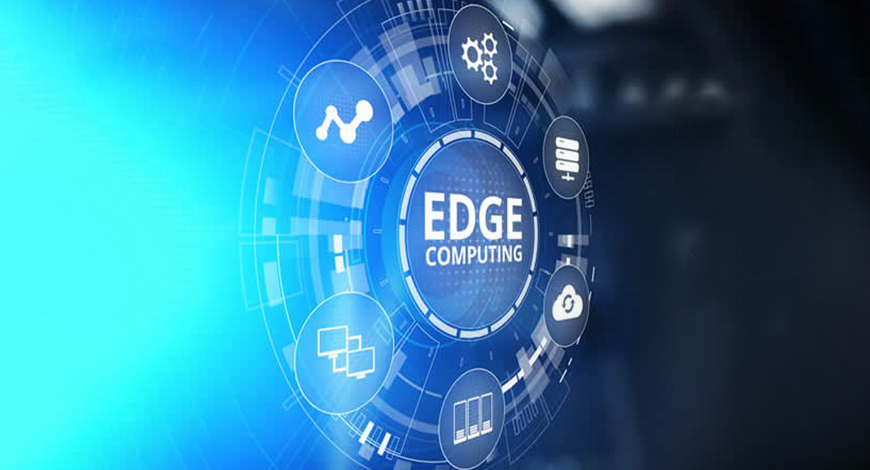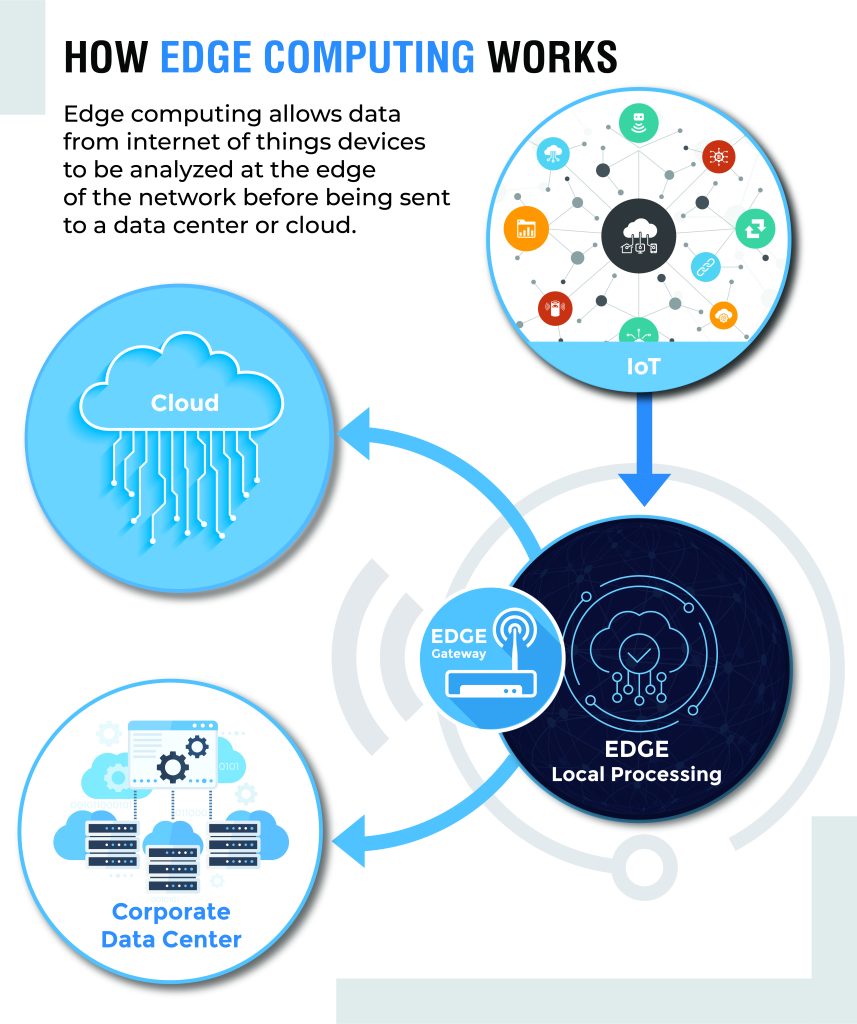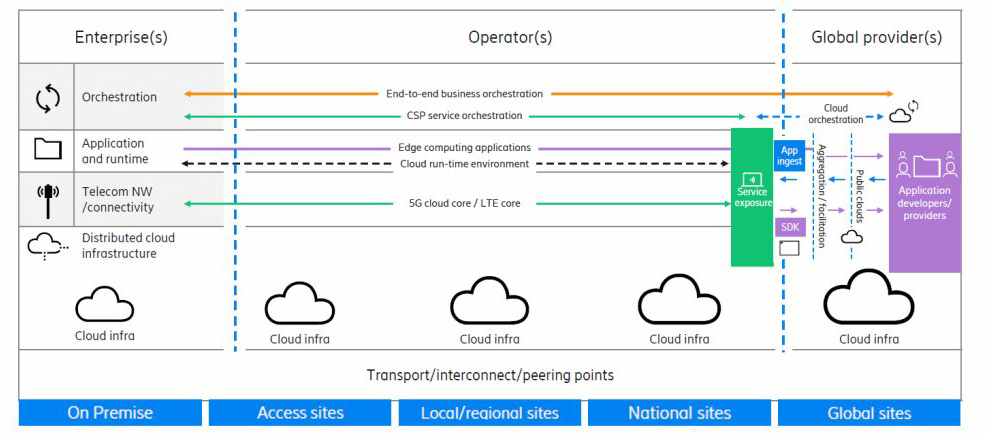CT Stories
The runway to digital-first operations

What makes edge so exciting is the potential it has for transforming business across every industry and function, from customer engagement and marketing to production and back-office operations
Edge allows businesses to bring the digital world into the physical. Bringing online data and algorithms into brick-and-mortar stores to improve retail experiences; creating systems that workers can train and situations where workers can learn from machines; designing smart environments that look out for our safety and comfort – what these examples all have in common is edge computing, which is enabling companies to run applications with the most critical reliability, real-time, and data requirements directly on-site. Ultimately, this allows companies to innovate faster, stand up new products and services more quickly, and open up possibilities for the creation of new revenue streams.
What makes edge so exciting is the potential it has for transforming business across every industry and function, from customer engagement and marketing to production and back-office operations.
There is a massive uptick in interest in edge computing, although adoption is still a little behind. The overall market is fairly small today but is expected to become significant over the next three to four years, and by 2025 it will become almost comparable to what the public cloud market looks like today.
While a couple of market research companies value the global edge computing market at USD 10.3 billion in 2022, expected to expand at a compound annual growth rate (CAGR) of 38.9 percent from 2022 to 2030 to reach USD 143 billion by 2030, IDC expects worldwide edge spending, with USD 176 billion in 2022 to reach USD 274 billion in 2025, growing at 18.7-percent CAGR over that period.
“Edge computing continues to gain momentum as digital-first organizations seek to innovate outside of the data center,” said Dave McCarthy, research vice president, of Cloud, and Edge Infrastructure Services at IDC. “The diverse needs of edge deployments have created a tremendous market opportunity for technology suppliers as they bring new solutions to market, increasingly through partnerships and alliances.”
IDC has identified more than 150 use cases for edge computing across various industries and domains. The two edge use cases that will see the largest investments in 2022 – content delivery networks and virtual network functions – are both foundational to service providers’ edge services offerings. Combined, these two use cases will generate nearly USD 26 billion in spending this year. In total, service providers will invest more than USD 38 billion in enabling edge offerings this year.
Edge use cases. For enterprise adopters, the edge use cases with the largest investments in 2022 include manufacturing operations, production asset management, smart grids, omnichannel operations, public safety and emergency response, freight monitoring, and intelligent transportation systems. Use cases that will see the fastest spending growth over the 2020–2025 forecast include public infrastructure maintenance, network maintenance, anatomy diagnostics, and AR-assisted surgery.
Across enterprise end-user industries, discrete and process manufacturing combined will invest USD 33.6 billion in edge solutions this year. Retail and professional services will also see spending of more than USD 10 billion on edge computing in 2022, while all 19 industries profiled in the Spending Guide, will experience double-digit spending growth over the five-year forecast period.
“In the service provider segment, a five-year compound annual growth rate (CAGR) of 21.6 percent reflects the edge infrastructure buildout underway to deliver edge cloud services,” said Marcus Torchia, research vice president, Customer Insights & Analysis group, IDC. “For enterprise edge technology buyers, growing at a 14.1-percent CAGR, provisioned services such as IaaS will grow significantly and capture an increasing share of total expenditures over the forecast period.”
Hardware and services spending is expected to account for 85 percent of all edge spending in 2022 with the remainder going to software, says IDC. Hardware spending will be led by investments in edge gateways, which feature low-power components, designed for running limited or single functions in environments where power and cooling availability is limited.
Investments in compute and storage assets adapted for edge locations or deployment will grow at a faster rate, and will nearly equal spending on edge gateways by the end of the forecast period. Services spending, comprised of professional and provisioned services, will grow at a faster rate than the other two groups with a five-year CAGR of 19.6 percent. By 2025, services will account for nearly 50 percent of all edge spending, led by investments in provisioned services, including connectivity and edge-related infrastructure-, platform-, and software-as-a-service (IaaS, PaaS, and SaaS). Software spending will primarily be allocated toward system infrastructure and security software with analytics and AI software seeing faster growth within the group.
Edge computing adds a layer of complexity to the organization by enabling a diverse set of stakeholders to maintain IT infrastructures, networking, software development, traffic distribution, and service management. Edge also combines software and hardware solutions and networking architecture to cover various use cases in several businesses.
Edge computing is going mainstream with various deployment models. Considered the next frontier in distributed computing, based on its proximity to the end device, and round-trip latency to the core of the data center, edge computing could be broadly categorized as IoT edge, on-premise edge, access edge, and the network edge, with latency as the critical factor.

Latency expectation at the IoT edge is usually less than 1 millisecond, at the on-premise edge less than 5 milliseconds, and at the access edge and network edge less than 10–40 milliseconds. Data from across multiple IoT edges, on-premises edges, and access edges, catering to the specific region, needs to be aggregated before connecting to the centralized data center that can span across a vast set of regions. And this type of deployment could be broadly called network edge or near edge in relation to the core data center of the service provider.
These four types provide the space or domain at which one would operate and draw out interfaces and interactions to be able to scale across edge types.
Edge computing strategies are crucial for an organization to meet its edge goals, says Gartner. By 2025, 50 percent of edge computing solutions, deployed at enterprises before a cohesive strategy has taken shape, will fail to meet deployment time, functionality, and cost goals predicts the leading technology research and consulting firm.
“Digital transformation is absolutely happening, and it doesn’t just happen to the backend. That’s what the cloud is giving us. It happens on the front end, and it’s going to happen at the edge,” Gartner Analyst Thomas Bittman said. He defined edge computing as part of distributed computing architecture “anywhere between that backend cloud or data center and that physical edge. Everything is fair game.”
According to Gartner, key considerations of an edge-computing strategy include a clear vision, specific use cases, potential challenges, standards or best practices, and deployment execution.
“You have got to start with a vision,” and it should integrate the edge strategy with other areas of the organization like cloud strategy, Bittman said. “This isn’t something that stands alone.” He recommended organizations draft a vision statement for the edge that ties tech investments to business value and disseminate that statement to gather executive buy-in and sponsorship.
All edge use cases are unique, depending on the type of industry, equipment, and interactions in question. This high diversity makes it incredibly difficult to put a general edge plan or architecture in place, and it makes it difficult for vendors in the space to turn a profit, Bittman explained. “But that’s going to change.”
Edge computing best practices. Identifying and managing edge computing risks, inhibitors, and challenges is another important piece of designing an edge computing strategy. Bittman recommended exploring how challenges like those associated with distributed computing, distributed data, security, and privacy, and extensibility may impact an organization’s edge ambitions. Enterprises should decide which challenges will need to be overcome and put a special focus on solving those challenges in terms of management, investment, and skills.
Bittman also highlighted how the lack of edge computing standards and broadly accepted architectures will render more than 85 percent of enterprise tech stacks incompatible in reality. He suggested organizations create an architecture function focused on edge computing, design and maintain architecture standards, determine best practices outside the enterprise and from enterprise deployments, and develop specific edge computing skills, roles, and responsibilities within the organizational structure.
In addition, edge proofs of concept (PoCs) shouldn’t be blindly trusted, Bittman argued, citing Gartner research that predicts 50 percent of edge computing solutions that worked fine as PoCs will fail to scale in production through 2022. To that point, he recommends enterprises require highly specific PoCs that address unique edge requirements like scale and tolerance to disconnection.
And then once an edge solution is deployed, Bittman noted requirements will likely change, the scale will grow, and new use cases and risks will emerge over time. Enterprises should design a process to manage the evolution of edge in production, in particular relating to how workloads, data, scale, and use cases shift over time.
Edge computing has a bright future because of the advancement of smarter devices and the ability of computers to process and send complex data. The growing need for quick, secure access to data is exactly what businesses and consumers want, and edge computing satisfies that need.
Thus far, edge computing is integrating AI, IoT, and 5G technologies and is expected to add value to businesses. Utilizing the importance of data through edge computing will reduce workloads and optimize networks and services to provide customers with flexible offerings. In addition, as more devices become internet-connected, organizations will become more dependent on them, which will help them succeed in this cutthroat environment.
The intelligent edge is key to expanding AI to more use cases in more industries. The intelligent edge works by processing data as close to its source or end-user as possible. By keeping data, applications, and computing power away from a centralized network or data center, the intelligent edge makes real-time AI possible. Intelligent edge architecture offers reduced latency, better network adaptability, and improved data security, helping to meet the challenges of traditional cloud-based AI solutions. Healthcare, automotive, and manufacturing are a few of the industries that can benefit from the power of edge AI.
The introduction of 5G and edge computing is opening a world of new revenue opportunities to provide new offerings both to enterprises that need to automate industrial processes and to consumers who require improved user experiences for online gaming. Edge computing provides distributed computing and storage resources closer to the location where it is needed and targets new business opportunities that provide support for specific application use cases. Some examples are augmented and virtual reality, manufacturing, and automotive. The innovation rate in this part of the application ecosystem will be significant going forward.
The edge application environment enables CSPs to host non-telco workloads and open up the network as a distributed cloud resource. Enterprises can develop applications, deploy and manage them flexibly via orchestration logic toward a landing zone, which accesses the distributed cloud infrastructure and leverages services exposed through APIs for consumption.

The edge computing landscape. A vast number of companies participate in the ecosystem, from hardware vendors, and platform companies to applications developers, system integrator (SI) companies, and CSPs. Two other key players in the ecosystem are the hyper-scale cloud providers (HCP) and operations technology (OT) vendors.
HCPs, such as AWS, Microsoft Azure, Google, and AliCloud have the core business to provide cloud infrastructure and platforms. They own application ecosystems with thousands of contributing developers and can serve multiple enterprises in several sectors on a global basis. HCPs are keen to be ecosystem drivers for edge computing.
OT vendors have IoT platforms and applications, supported by edge-computing components. Some examples of these companies include Siemens, General Electric, BMW, and ABB. They have strong enterprise relationships, especially in the manufacturing sector. Companies looking to do a smart manufacturing deployment are likely to partner with an OT vendor to a certain extent. OT vendors are establishing relationships with HCPs for global deployments of their solutions, access to the application development ecosystem, and an environment to create and deploy their own applications.
SI companies have a wide range of capabilities to address enterprise pain points, related to solution implementation and integration of offerings from different ecosystem companies. SI companies can be both global and local and are likely to be present in most solution implementations in one way or another. Apart from specialized SI companies, other companies can also take an SI role in solution implementation, for example, OT vendors or HCPs.
Edge computing is specified across several standards and open source for a. The edge computing ecosystem is very dynamic, with many new initiatives from various organizations and companies. Just in the open-source area, there are at least 20 initiatives ongoing across different communities as this paper is being written. There is no industry standard agreed upon as yet, covering all aspects of edge computing, even after years of efforts by some standardization bodies. Edge computing is being specified across standards and open-source fora, for example, 3GPP, which has accelerated its activities toward the edge, ETSI, CNCF (cloud native computing foundation), ONAP (open network automation platform), and LF edge. In addition, there are several industry alliances aligning around their own use cases. Two good examples are AECC (Automotive Edge Computing Consortium) and 5G-ACIA (5G Alliance for Connected Industries and Automation).
Outlook. With increasing interest in new use cases and services like smart manufacturing, augmented and virtual reality, and the high interest in online gaming, there is a clear need for edge computing. However, the edge is not a standalone product or an offering but an enabler for use cases requiring security, resilience, and low latency, in combination with other technical solutions like private networks.
The edge-computing ecosystem is vast and is evolving rapidly. Many organizations and companies are involved in specifying the technology and defining solutions. This runs the risk of market fragmentation, leading to slower uptake of services. The industry can avoid fragmentation by making sure that differentiation is done on services, not on how they are consumed or exposed.
Edge computing covers a vast number of use cases, but there is no one solution that fits them all. CSPs should choose the one that suits their enterprise strategy best, and should be prepared to build strength by partnering with HCPs, SI companies, or OT. With increasing interest in new use cases and services like smart manufacturing, augmented and virtual reality, and the high interest in online gaming, there is a clear need for edge computing. However, the edge is not a standalone product or an offering but an enabler for use cases requiring security, resilience, and low latency in combination with other technical solutions like private networks.
The edge-computing ecosystem is vast and is evolving rapidly. Many organizations and companies are involved in specifying the technology and defining solutions. This runs the risk of market fragmentation, leading to slower uptake of services. The industry can avoid fragmentation by making sure that differentiation is done on services, not on how they are consumed or exposed.
Edge computing covers a vast number of use cases, but there is no one solution that fits them all. CSPs should choose the one that suits their enterprise strategy best, and should be prepared to build strength by partnering with HCPs, SI companies, or OT vendors while keeping a strong GTM toward enterprises.
CSPs can choose different roles, a single role or a combination of roles, and deployment tracks depending on their ambition in the enterprise area beyond providing connectivity. These roles are categorized based on whether service providers want to build edge infrastructure and whether they want to front the enterprise.
Having said that, the technology refuses to take off. Industry analysts, computing executives, and telecom professionals continue to hype the technology as the next big revolution for the digital age. After all, the technology promises to dramatically improve not only the speeds and performance of internet connections but to also upend the very bones of the world’s global internet network by placing computing services geographically closer to users.
However, those broad hopes have yet to pan out. Early efforts have yet to result in a clear payoff. “Our report outlines the potential demand for edge computing, however, it is also fair to say that it is still unknown where it will be deployed or what it will effectively be, and without an application to drive it, it is very hard to describe what the target vertical will be,” says BofA analysts in its October report. “As such, we are cautious to make firm determinations on the potential users/verticals of edge compute.”















You must be logged in to post a comment Login